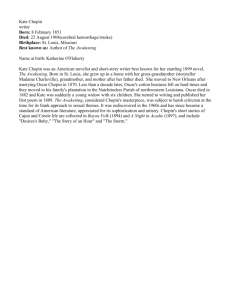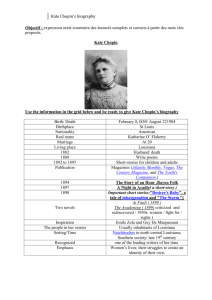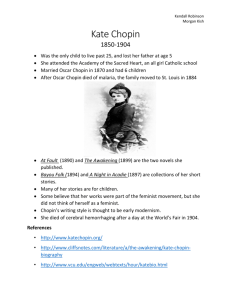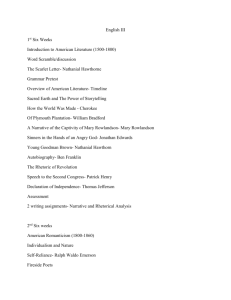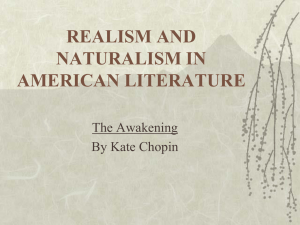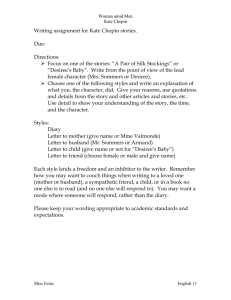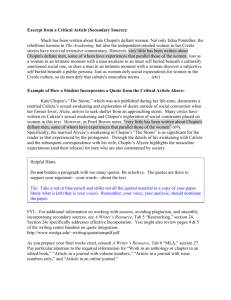The Story of an Hour by Kate Chopin
advertisement
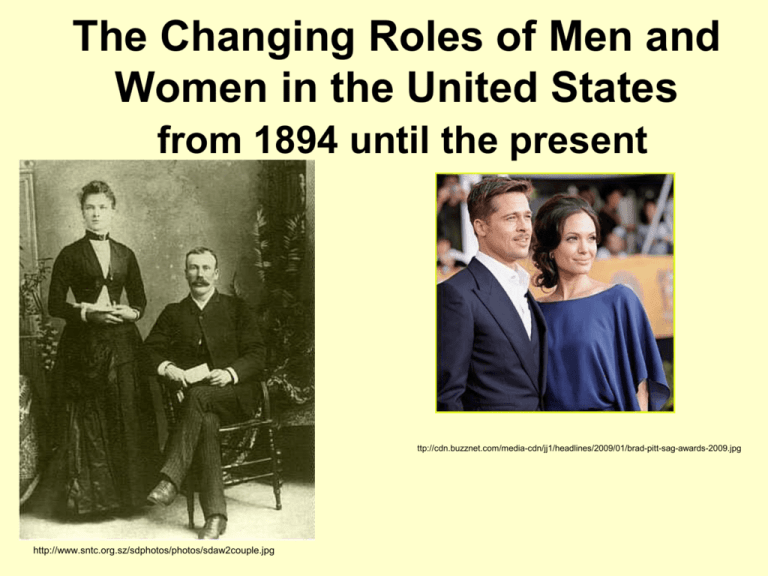
The Changing Roles of Men and Women in the United States from 1894 until the present ttp://cdn.buzznet.com/media-cdn/jj1/headlines/2009/01/brad-pitt-sag-awards-2009.jpg http://www.sntc.org.sz/sdphotos/photos/sdaw2couple.jpg What was life like for men and women in 1890 in the U.S.? The 1890’s was part of the second Industrial Revolution—The Gilded Age of substantial growth in the U.S. population. The extremely wealthy lived lavishly and industries grew. There were huge disparities between the rich and poor. http://www-tc.pbs.org/marktwain/scrapbook/05_gilded_age/images/05_cover.gif There were opulent homes ... http://www.erasofelegance.com/arts/architecture/southern.jpg And modest or poor homes and living conditions Tenement Home Shotgun Style Home 1890 http://www.rootsweb.ancestry.com/…/misc/?-M%3BO=D http://kclibrary.lonestar.edu/tenement.gif The New South The setting of the short story we will read today • Civil War • The New South Reconstruction lasted from 1865-1877. • Many from the poverty-stricken rural Southern United States were employed in textile jobs, including women and children. http://www1.cuny.edu/portal_ur/content/voting_cal/photos/reconstruction_01.jpg From Farming to Industrial Living in the United States • What do you think life was like for families in the United States in the 1890’s? • What traditional roles do you believe men and women fulfilled? • Who had the power? • Who handled child care? • Were their roles complimentary? Male/Female Roles on the Farm http://newsimg.bbc.co.uk/media/images/44077000/jpg/_44077273_416bwsfield.jpg What roles did men and women fulfill on the farm? Workers in Southern Textile Mills Textile Mill http://www.historycooperative.org/…31.1/malone.html A Few Things to Consider . . . • African American men received the right to vote with the passage of the 15th Amendment in 1870. • The Woman’s Suffrage Movement was sidetracked by the Civil War. • Women received the right to vote with the passage of the 19th Amendment in 1920. More Things to Consider . . . • Property rights laws for married women had not been passed in all states in the United States as of 1890. • Ownership of women’s property was transferred to their husbands upon marriage. • Divorce carried social stigma and property reverted to the husband. Are men and women free to choose their roles today? In what ways are they stifled or confined by their assigned gender roles? Roles of Men and Women Today • Men and women are free to work in any profession they choose. • Men or women may choose to work outside the home or inside the home. • Many men opt to stay home to raise their children while their wives work. • Men and women have a voice in government and serve in political office. Kate Chopin February 8, 1850 – August 22, 1904 Brief Biography of Kate Chopin • Born Catherine O’ Flaherty in St. Louis, Missouri to a wealthy family. • Lived in the City of St. Louis during the Civil War. • Married cotton trader, Oscar Chopin, in 1870. • Gave birth to five sons and a daughter between 1871 and 1879. • Oscar died of malaria in 1882. More about Kate Chopin • Although she grieved the death of Oscar, her writing career took off after his death. • She published short stories in Harpers, Atlantic Monthly and Vogue, some during her marriage. • Her literary idol was Guy de Maupassant. • She also studied: • Charles Darwin • Mary Wilkins Freeman • Sarah Orne Jewett Other Influences • Kate and Oscar Chopin traveled throughout the U.S. and Europe on their honeymoon. • She developed a progressive world-view and a social conscience. • She used her literature to bring women’s issues, racial disparity, and social inequalities to light. Some of Kate Chopin’s Short Stories • • • • • • • • “The Storm” “The Story of an Hour” “Desiree’s Baby” “A Pair of Silk Stockings” “Athenaise” “At the Cadian Ball” “Lilacs” “A Respectable Woman” Kate Chopin’s Novels • At Fault • The Awakening Prevalent Themes of Chopin’s Short Stories and Novels • • • • Inequities of traditional marriage Motherhood Class division Arbitrary race distinctions in Southern culture • Women’s search for identity • Women’s revolt against social norms and conformity Kate Chopin’s Home: Natchitoches near Cloutierville Parish Louisiana http://pics4.city-data.com/cpicv/vfiles8720.jpg The Story of an Hour by Kate Chopin Wikisource Librivox Sources • • • • • • Websites: http://www.wic.org/misc/history.htm http://www.britannica.com/EBchecked/topic/366 305/Married-Womens-Property-Acts http://en.wikisource.org/wiki/The_Story_of_an_H our http://www.1.cuny.edu/…/voting_cal/reconstructi on.html http://www.womensenews.org/article.cfm/dyn/aid /1414/context/archive Sources Continued • Gilbert, S.M., & Gubar, S. (1996). The norton anthology literature by women: The traditions in English (2nd ed.) New York: Norton & Co. • Lewis, R. A., & Sussman, M. B. (1986). Men’s changing roles in the family. New York: The Hawarth Press. • Goldfield, D., Abbott, C., Anderson, V.D., Argersinger, J.E., Argersinger, P.H., Barney, W.L., et al. (2002). The American journey: A history of the United States custom edition for Texas Woman’s University. Boston: Pearson Custom Publishing.

